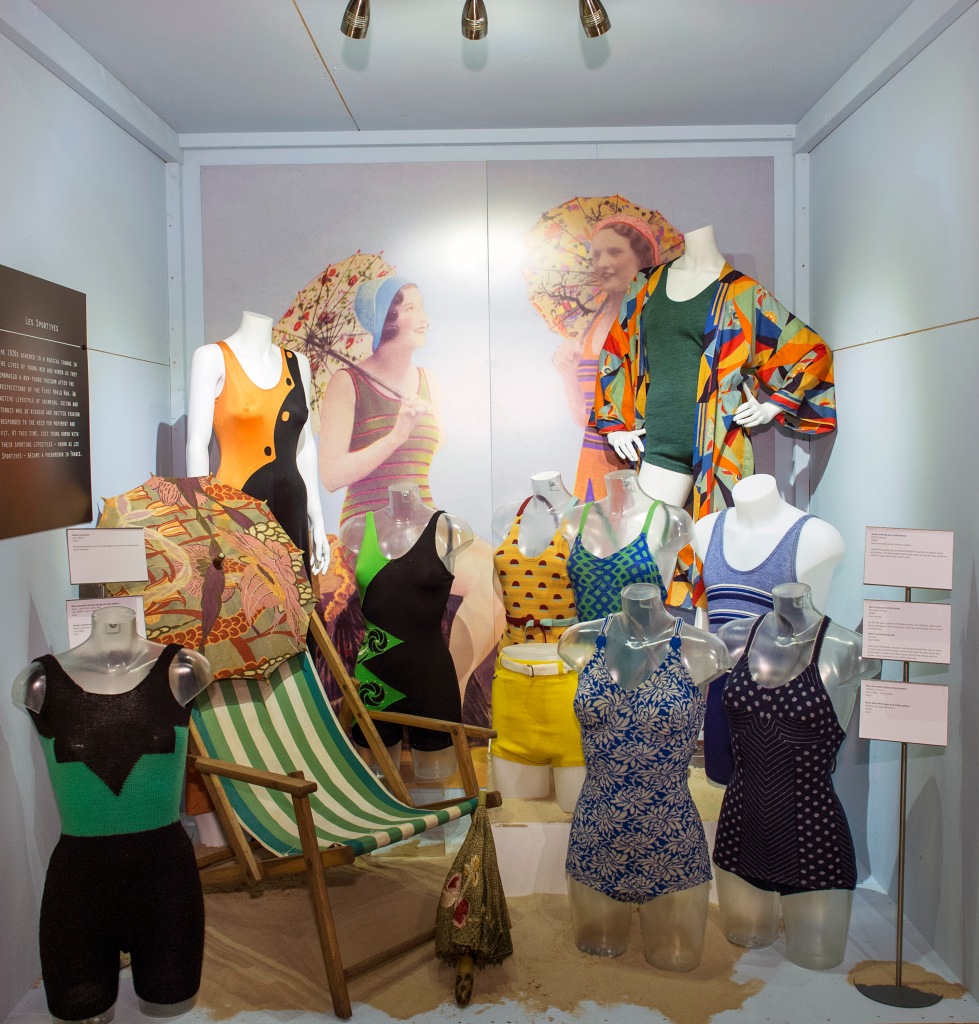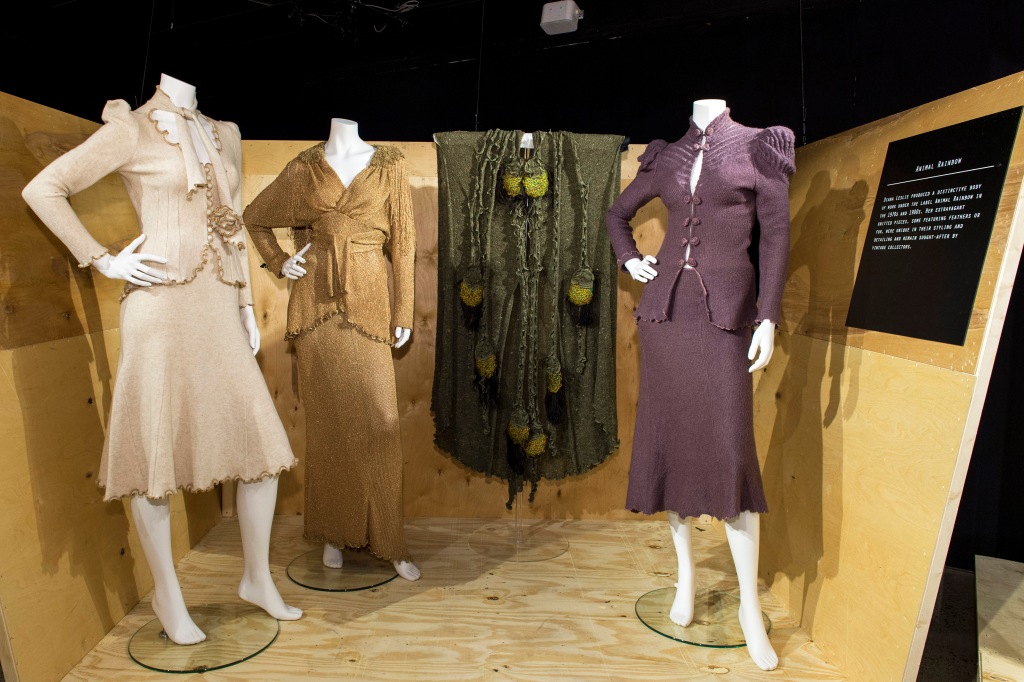Introduction
Knitting is one of the most fundamental textile techniques, produced from a continuous yarn and simple needles, yet its origins are shrouded in the mists of time. Early examples of knitting dating from Coptic and Egyptian cultures still exist, along with hats, stockings and knitted undergarments from the sixteenth century. While their earliest history may never be known, knitted items retain an immediacy and an association with those who wear or create them.
The examples discussed here are taken predominantly from the private collection of Mark and Cleo Butterfield, whose passion for knitted garments co-exists with their work as some of the country’s most important collectors of antique and vintage clothing and accessories. The exhibition emulated their personal approach rather than attempted to create a comprehensive historical overview; it reflected the emotions we invest in objects rather than presenting an academic investigation.
The Butterfields‘ love affair with knitting began in the 1960s with a jumper knitted by a teenaged Cleo from a 1940s pattern, and continues today with a wide-ranging collection across a century’s worth of knitted fashions, taking in anonymous hand knits, machine knits and jerseys, through to crocheted pieces and experimental high fashion.
A Functional Art
Knitting in the late Victorian and Edwardian era tended towards functional garments that made a virtue of its warmth and flexibility. Most knitwear was produced by hand and the art of lace knitting was a popular technique used to produce a variety of accessories; patterns existed for shawls, mittens, caps and petticoats. Knitting was not limited to women – many men, including soldiers and sailors, knitted as a practical pastime.
Freedom and Fashion
By the advent of the First World War, knitwear had acquired a new fashionable status, coinciding with women’s increasingly active lifestyles. Women’s attitudes to dress were changing and knitted sportswear had become a popular choice for golf, cycling and motoring as well as for comfortable garments for informal occasions. Gabrielle ‘Coco’ Chanel’s introduction of cardigans, jumpers and suits in woollen jersey – a fabric originally destined for men’s undergarments – revolutionised women’s couture fashion when she opened her Deauville boutique in 1913.
Les Sportives
The 1920s ushered in a radical change in the lives of young men and women as they embraced a new-found freedom after the restrictions of the First World War. An active lifestyle of swimming, skiing and tennis was de rigueur and knitted fashion responded to the need for movement and fit. At this time, chic young women with their sporting lifestyles – known as les sportives – became a phenomenon in France.

Chanel’s Influence
Chanel’s elegant styles of the 1920s, termed “poverty de luxe” by rival couturier Paul Poiret, influenced a generation of designers. Other couturiers, such as Jane Régny and Jean Patou, also promoted a similar pared-down style of couture. Chanel’s striped and checked jersey twinsets in neutral colours remain understated classics of 1920s modernism.

Chic Crochet
Crochet, a technique close to knitting, gained popularity in the 1920s as the boxy shapes it created related to the fashions of the period. A wide range of crocheted dresses, tunics and jackets from the era can be found and were included in many of the craft pattern books of the day.
Glamorous Night
Dressing for the evening in the 1920s and 1930s reached a peak of glamour and sophistication, with knitted and crocheted dresses, coats and wraps created using a variety of techniques. Featuring metallic yarns, deco colouring and exotic details, these pieces represent the artistic circles and café society that grew up in Paris, London and New York.

Stylish Everyday
Knitted day dresses, sweaters and suits were stylish and sophisticated options during the 1930s. Italian couturier and friend of the Surrealists, Elsa Schiaparelli’s career began with a knitted sweater featuring a trompe-l’œil bow. She introduced witty touches to serious fashion and her sportswear – that is, clothes worn by the spectators – included many machine- and hand-knitted items.

Make Do and Mend
During the Second World War, clothing rations meant that British women had to find creative ways of recycling garments – one of which was the unravelling of old sweaters. This recycled yarn was then knitted into multicoloured jumpers that made a feature of the variety of wools being re-used. Patterns were produced by the government to promote the re-use of garments, while a ‘CC41’ mark designated the restricted use of materials for new ‘utility’ clothing and can be seen on the labels of garments produced at this time.

Knit American Style
In the USA, knitwear took a fashionable turn in the 1940s as Hollywood stars were photographed and filmed by the studios in knitted garments. Lana Turner’s early career was defined by her nickname of “The Sweater Girl”. Men’s casual knitwear was also popular and reflected both collegiate and Native American styles.

Fashionable Folk
Designers such as Elsa Schiaparelli introduced folkloric and traditional themes from across Europe into their knitwear. This trend continued through the 1930s and 1940s and was popular with home knitters as well as fashion companies. Motifs from the Alpine regions, Scandinavia and Eastern Europe provided sources of inspiration for this look.
The Fair Isle
Originating from a tiny island off the coast of Scotland, Fair Isle now refers to a style of intricately patterned sweaters worked in bands. The Fair Isle’s place in fashion history was secured when a jumper was sent to Edward, Prince of Wales, as a gift from the islanders in the 1920s. He was subsequently photographed wearing it while playing golf, sparking an international trend. The Fair Isle’s popularity peaked again in the 1970s, when it was picked up as part of the decade’s retro revival.

Cocktail Hour
The 1950s saw the introduction of that era’s main contribution to knitwear – the cocktail sweater. These glamorous evening knits featured a defined waist and a decorative element. Necklines and cuffs would often be richly embroidered with floral motifs or embellished with jewels. Made to be worn with full or pencil skirts, they provided a contemporary twist for evening dressing.

Crochet Your Way
Crochet experienced a renaissance in the 1960s and 1970s when its home-made quality and implied youthfulness struck a chord. A variety of commercial patterns was available, allowing women to create their own looks. Fashion designers of the era also utilised crochet techniques as a construction method or decorative feature.
The Future Starts Here
Designers Rudi Gernreich and André Courrèges were at the forefront of fashion’s futuristic moment. Up-to-the-minute Space Age styling was a key trend of the mid-1960s and knitted, stretch fabrics helped to define the streamlined look. Gernreich’s work was inspired by dancewear and the need for movement, and Courrèges’s optimistic clothes galvanised the staid world of Paris haute couture.
The Novelty Factor
Novelty knitwear was a hit in the 1970s. Pop art references and tongue-in-cheek styling were embraced by both high fashion and the mass market. While leading companies such as Fiorucci and Kenzo produced popular styles, the look reached its apogee with knitwear company Ritva’s collaboration with of-the-moment visual artists such as Elisabeth Frink and Allen Jones; these pieces became instant collectors’ items.
Designing the 1970s
Knitwear was an integral feature of fashion in the 1970s. Spectrums of styles were produced, from the ethnic and nostalgic styles of the counterculture to Punk’s ripped up rebellion and, finally, New Wave’s romanticism during the last years of the decade. Designers such as Bill Gibb and Kaffe Fassett, Mary Quant, Rae Spencer-Cullen for Miss Mouse, and Biba all created distinctive designs with knit.
1980s Excess
Designer fashion exploded in the 1980s in a mix of high fashion and alternative street-based brands. This visually stimulating and image-rich era generated a wide range of knitted designs. Vivienne Westwood and Comme des Garçons produced influential, highly unique collections that challenged the status quo, while established labels, such as Zandra Rhodes and Sonia Rykiel, created sophisticated knitwear for the high-end market. Escada and Krizia were other well-known names producing designer knits.
Animal Rainbow
Diana Leslie produced a distinctive body of work under the label Animal Rainbow in the 1970s and 1980s. Her extravagant knitted pieces, some featuring feathers or fur, were unique in their styling and detailing and remain sought-after by vintage collectors.

A New Era
Designer Julien Macdonald revolutionised knitwear in the 1990s. His virtuoso use of knitting machines and experimental application of unorthodox materials changed the industry’s perceptions of knitted garments, electrified fashion and led to jobs with Chanel and Givenchy, in addition to the creation of his eponymous label.

We do hope you’ve enjoyed exploring the Fashion and Textile Museum online. If so, please consider making a donation to help us continue our work.

Thank you for sharing with the now not so new generation.
LikeLike